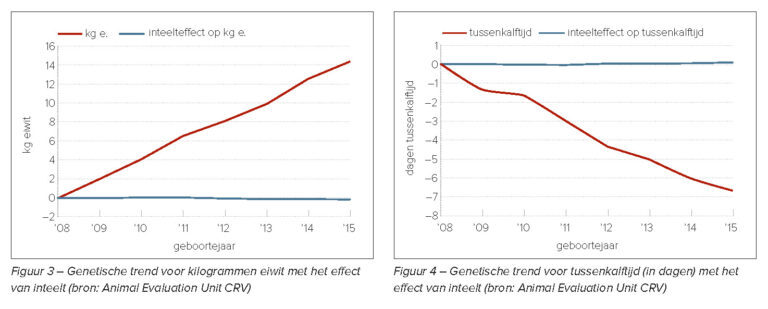Genetic progress and inbreeding. They might seem diametrically opposed, but they are inextricably linked in pure-bred breeding programmes. ‘In a closed population of animals, inbreeding inevitably increases over time. But if animals with the desired traits are selected and mated within a breed, inbreeding will increase at a faster rate’, Harmen Doekes, research associate in Animal Breeding and Genomics at Wageningen University and Research explains this relationship. The negative effects of inbreeding have been known for a long time, but serious attention has only been paid to this in breeding for the past 30 years.
Science monitors inbreeding

Inbreeding is a threat to the vitality of a cow population but is always waiting in the wings in a breeding programme. CRV closely monitors the development of the rate of inbreeding in various breeds. Vigilance is vital, but so far, any negative effects have been limited.
Inbreeding is always waiting in the wings and therefore has the full attention of scientists, herdbook organisations and breeding technicians. In this series they explain the steps they take to limit inbreeding.
Genetic progress

Inbreeding in practice: limited effect of inbreeding depression
The effect of inbreeding depression is almost negligible, according to a study conducted in 2017 on the effects of inbreeding depression in Holstein cattle. It is far outweighed by the effect of genetic progress, according to the same research (see figure 1). For example, in the period 2008-2015, genetic progress was +14.3kg of protein, while the effect of inbreeding depression was –0.13kg of protein. In the same period, genetic progress reduced the calving interval by 6.7 days, while the effect of inbreeding depression was an increase of 0.07 days.
Inbreeding determines vitaltity
The speed at which the rate of inbreeding increases determines the vitality of the breed. The FAO, the food and agriculture organisation of the United Nations, advises an increase in the inbreeding rate of 1% per year as a safe limit. In terms of an average generation interval with cattle of four years, which converts to increase of 0.2% per year.
CRV also monitors inbreeding
CRV closely monitors developments in the rate of inbreeding. ‘As a herdbook organisation, we do this to provide farmers and breeding organisations with insight’, says Mathijs van Pelt, researcher at the Animal Evaluation Unit (AEU) of CRV. ‘We calculate the current rate of inbreeding in various breeds on a regular basis. These figures are reported to the government. The report is publicly available for download on the CRV website.

“Thanks to genomic marker testing, it is relatively easy to map the genomes of large numbers of animals to search for animals with the desired traits, but with a low kinship with the rest of the population”
Science: using genomic selection as a tool to stop an increase in inbreeding
The quicker increase in the rate of inbreeding in Holsteins over the past ten years is often attributed to the use of genomic selection. Researcher Harmen Doekes takes a more nuanced view. ‘Genomic selection in itself does not result in more inbreeding’, he stresses. ‘What using genomic breeding values does do is enable faster and more defined selection, making it even more important to monitor inbreeding.’ According to the researcher, genomic selection could also be used as a tool to stop the increase in inbreeding. ‘Thanks to genomic marker testing, it is relatively easy to map the genome of large numbers of animals to search for animals with the desired traits, but with a low kinship with the rest of the population’ says Doekes as an example. Another example is selection within a group of animals with the same pedigree, for instance full brothers. ‘It could be that one brother has more genes in common with the population than the other brother’, he explains. ‘Research is revealing more understanding about the genome of animals’, the researcher says. ‘Now that we use DNA information for selection, we can also use the same information to limit inbreeding, although this requires further research. In addition, science has a signalling and advisory role. It is ultimately down to breeding organisations and farmers to use the insights and tools that have been developed.’
SireMatch excludes risk of inbreeding
Based on your breeding goal and the pedigrees, breeding values and performance of your cattle, the mating program SireMatch generates the best mating propositions. This apporach exludes the risk of inbreeding.
Summary
- The increase in inbreeding in the Holstein breed has remained below the ‘safe’ limit of 0.25% percent per year until now, including internationally.
- Inbreeding depression has hardly any measurable impact on the performance of cows at present.
- The influence of genomic selection on the rate of inbreeding is not yet visible.
- Genome research allows inbreeding calculations to be further refined.
